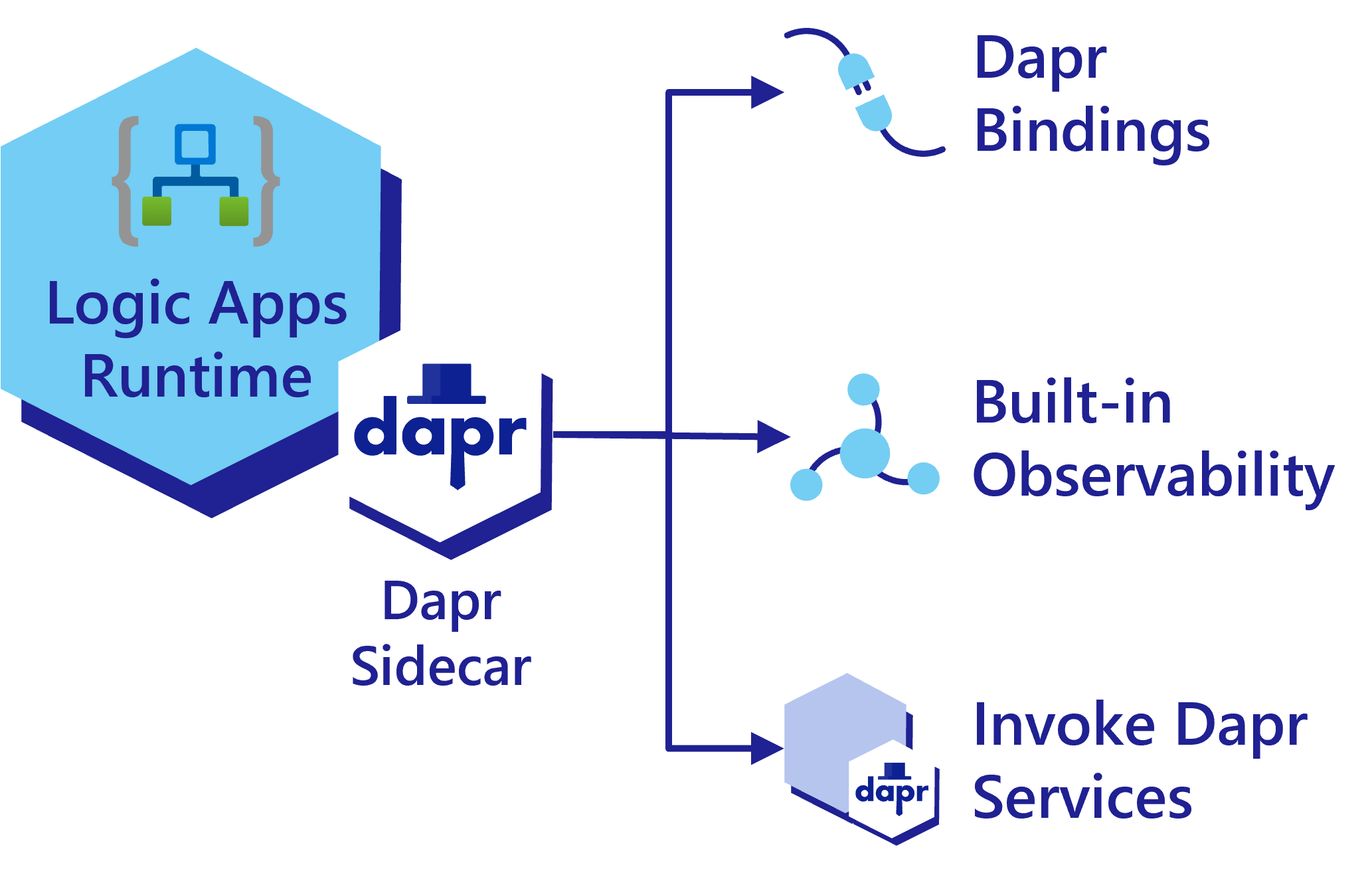The documentation you are viewing is for Dapr v1.4 which is an older version of Dapr. For up-to-date documentation, see the latest version.
Build workflows with Logic Apps
Dapr Workflows is a lightweight host that allows developers to run cloud-native workflows locally, on-premises or any cloud environment using the Azure Logic Apps workflow engine and Dapr.
Benefits
By using a workflow engine, business logic can be defined in a declarative, no-code fashion so application code doesn’t need to change when a workflow changes. Dapr Workflows allows you to use workflows in a distributed application along with these added benefits:
- Run workflows anywhere: on your local machine, on-premises, on Kubernetes or in the cloud
- Built-in observability: tracing, metrics and mTLS through Dapr
- gRPC and HTTP endpoints for your workflows
- Kick off workflows based on Dapr bindings events
- Orchestrate complex workflows by calling back to Dapr to save state, publish a message and more

How it works
Dapr Workflows hosts a gRPC server that implements the Dapr Client API.
This allows users to start workflows using gRPC and HTTP endpoints through Dapr, or start a workflow asynchronously using Dapr bindings. Once a workflow request comes in, Dapr Workflows uses the Logic Apps SDK to execute the workflow.
Supported workflow features
Supported actions and triggers
Supported control workflows
Supported data manipulation
Not supported
Example
Dapr Workflows can be used as the orchestrator for many otherwise complex activities. For example, invoking an external endpoint, saving the data to a state store, publishing the result to a different app or invoking a binding can all be done by calling back into Dapr from the workflow itself.
This is due to the fact Dapr runs as a sidecar next to the workflow host just as if it was any other app.
Examine workflow2.json as an example of a workflow that does the following:
- Calls into Azure Functions to get a JSON response
- Saves the result to a Dapr state store
- Sends the result to a Dapr binding
- Returns the result to the caller
Since Dapr supports many pluggable state stores and bindings, the workflow becomes portable between different environments (cloud, edge or on-premises) without the user changing the code - because there is no code involved.
Get started
Prerequisites:
- Install the Dapr CLI
- Azure blob storage account
Self-hosted
-
Make sure you have the Dapr runtime initialized:
dapr init -
Set up the environment variables containing the Azure Storage Account credentials:
export STORAGE_ACCOUNT_KEY=<YOUR-STORAGE-ACCOUNT-KEY> export STORAGE_ACCOUNT_NAME=<YOUR-STORAGE-ACCOUNT-NAME>set STORAGE_ACCOUNT_KEY=<YOUR-STORAGE-ACCOUNT-KEY> set STORAGE_ACCOUNT_NAME=<YOUR-STORAGE-ACCOUNT-NAME> -
Move to the workflows directory and run the sample runtime:
cd src/Dapr.Workflows dapr run --app-id workflows --protocol grpc --port 3500 --app-port 50003 -- dotnet run --workflows-path ../../samples -
Invoke a workflow:
curl http://localhost:3500/v1.0/invoke/workflows/method/workflow1 {"value":"Hello from Logic App workflow running with Dapr!"}
Kubernetes
-
Make sure you have a running Kubernetes cluster and
kubectlin your path. -
Once you have the Dapr CLI installed, run:
dapr init --kubernetes -
Wait until the Dapr pods have the status
Running. -
Create a Config Map for the workflow:
kubectl create configmap workflows --from-file ./samples/workflow1.json -
Create a secret containing the Azure Storage Account credentials. Replace the account name and key values below with the actual credentials:
kubectl create secret generic dapr-workflows --from-literal=accountName=<YOUR-STORAGE-ACCOUNT-NAME> --from-literal=accountKey=<YOUR-STORAGE-ACCOUNT-KEY> -
Deploy Dapr Worfklows:
kubectl apply -f deploy/deploy.yaml -
Create a port-forward to the dapr workflows container:
kubectl port-forward deploy/dapr-workflows-host 3500:3500 -
Invoke logic apps through Dapr:
curl http://localhost:3500/v1.0/invoke/workflows/method/workflow1 {"value":"Hello from Logic App workflow running with Dapr!"}
Invoking workflows using Dapr bindings
-
First, create any Dapr binding of your choice. See this How-To tutorial.
In order for Dapr Workflows to be able to start a workflow from a Dapr binding event, simply name the binding with the name of the workflow you want it to trigger.
Here’s an example of a Kafka binding that will trigger a workflow named
workflow1:apiVersion: dapr.io/v1alpha1 kind: Component metadata: name: workflow1 spec: type: bindings.kafka metadata: - name: topics value: topic1 - name: brokers value: localhost:9092 - name: consumerGroup value: group1 - name: authRequired value: "false" -
Next, apply the Dapr component:
Place the binding yaml file above in a
componentsdirectory at the root of your application.kubectl apply -f my_binding.yaml -
Once an event is sent to the bindings component, check the logs Dapr Workflows to see the output.
In standalone mode, the output will be printed to the local terminal.
On Kubernetes, run the following command:
kubectl logs -l app=dapr-workflows-host -c host
Example
Watch an example from the Dapr community call:
Additional resources
Feedback
Was this page helpful?
Glad to hear it! Please tell us how we can improve.
Sorry to hear that. Please tell us how we can improve.